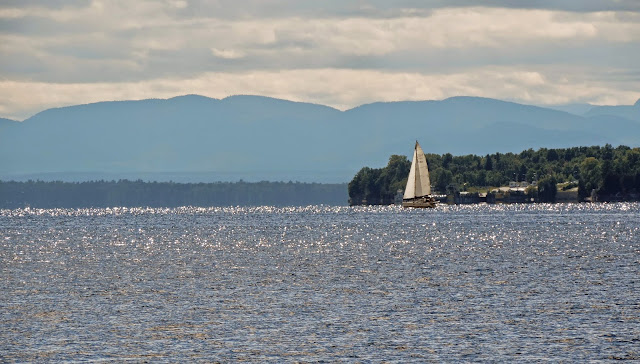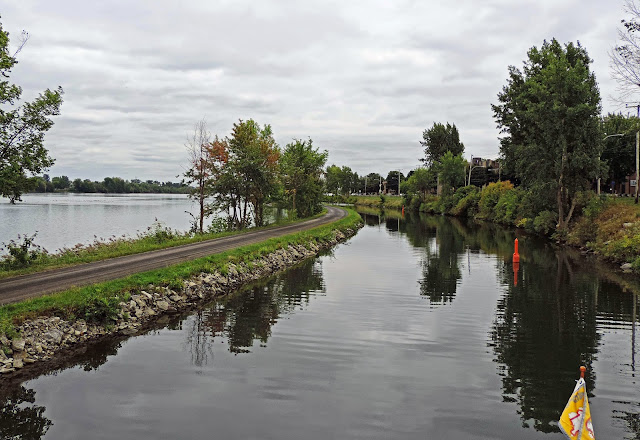Lake Champlain lies in a north/south orientation, a long and skinny lake that is the divider between the states of New York and Vermont. This view is looking south at the north end of the lake.
There are few communities along the lake that are large enough to qualify as a city. The largest city by a large measure, one that many would describe as only medium-sized, is Burlington, VT. It is Vermont's largest city and home to the University of Vermont. The lighthouse at the left of this image is on a breakwall that provides some protection to the marinas along the shore and a mooring field. "Some" is the operative term as this harbor is not recommended in rough weather.
A look at the city inside the breakwall. The city rises from the waterfront to the top of a hill where the old downtown streets parallel the water.
 Burlington is vibrant. The streets downtown are filled with people, all of whom have a spring in their step and a song in their voice. One main street has been turned into a pedestrian mall, a concept tried in many cities, but not with the success enjoyed here. Even on Sundays, every business is open and filled with customers.
Burlington is vibrant. The streets downtown are filled with people, all of whom have a spring in their step and a song in their voice. One main street has been turned into a pedestrian mall, a concept tried in many cities, but not with the success enjoyed here. Even on Sundays, every business is open and filled with customers.Every storefront is occupied and there is an inside mall, in historic buildings. It would be impossible to sample all of the interesting restaurants given a month visit. Oh, if it only were not so cold in the winter. Even in the summer, the residents tend to wear flannel and one of the stores on this street is a flannel shop.
A view from the marina. The breakwall can be seen with the wide lake appearing as only a sliver of shiny water.
A look back at Burlington as Last Dance continues her journey south. This more distant view gives a majestic image to this most interesting city.
Heading south from Burlington, one of the widest sections of the lake, a view of mountain ridges in New York dominate the horizon. In between two of those ridges, a protected bay is formed which Last Dance took advantage of for an anchorage.
At the end of the bay was a bulbous area, ringed by ridges on all sides. This protected spot is a perfect home to a marina, filled with sailboats. Most of the boats are owned by Canadians, who travel only a few hours south to a lake perfect for sailing.
Another view of the western shore of the lake, the New York side, with multiple ridges unspoiled with little development. This is typical of both shores of the lake. The trees, however, are new growth forest. The Champlain Valley and the Adirondack Mountains were voraciously logged for timber in the 18th and19th centuries. One Lake Champlain visitor in 1853 was quoted describing the valley: "One may now travel for miles in that region and not find a tree large enough to make a respectable fish-pole." The conservation activists of the 20th century must be credited for the now scenic, forested views.
Along some shores, the high ridges are right next to the lake. This ridge boasts a lighthouse. The small recreational trawler/tug traveling close to shore attests to the ridge continuing underwater at the same steep slope, creating good depth right to shore.
Toward the southern end of the lake a large peninsula, known as Crown Point, juts into the lake creating a narrows. This area has been used as a place to cross the lake from the days of native Americans. It had the first bridge spanning the lake, built in 1929, and now boasts a new, similarly-shaped bridge, opened in 2011. The dinghy is tied to a state park dock on the New York side of the lake. The grass reaching the top gives an indication of shallow water. Correctly so. Last Dance, anchored seemingly far from shore, is in only 6 feet of water.
The west end of the bridge lands in New York, on Crown Point, where auto travelers are welcomed by a road sign.
A major part of the state park on Crown Point is occupied by the ruins of two armed forts. It was first occupied by the French, who built Fort St. Frederic in 1734. The British engaged them in battle for four years, defeating them in 1759, burning the fort. That year, the British built a new fort, His Majesty's Fort, their largest fortification in North America.
South of the bridge, at the site of the old ferry dock, when ferries provided the transportation across the lake, the Samuel de Champlain Tercentennial Memorial lighthouse now stands.
The Vermont end of the bridge lands at Chimney Point, so named after the British defeated the French and burned all of the homes the French had built on the eastern shore, leaving only the chimneys standing.
Vermont has built a new floating dock under the bridge, making access easy for boaters. Since this spot has always been the easy place to cross the lake, travelers have been coming here for 9,000 years. Still remaining is the tavern and roadhouse built in the 18th century. It currently houses a museum archiving the history of activities occurring here.

One of the exhibits at the Chimney Point Museum depicts the horse-powered ferries that crossed the lake. This particular design had two horses walking on a circular treadmill, turning a shaft that was geared to two paddlewheels - ingenuity of applying available power to transportation prior to the steam engine.
While most people's image of New York is a huge city with a skyscrapered skyline, upstate New York is still farming country. And, farms extend right to the lakefront. Waterfront property used as a peaceful farm. Hopefully, Florida developers will not find this area.
At the southern end of Lake Champlain, and now the northern terminus of the NY Champlain Canal, lies the old town of Whitehall. At the time of the American Revolution, it was known as Skenesboro and was the site of the sawmill where Benedict Arnold built nine ships to engage the British in battle. High on the hill opposite town, the Skeene manor still stands.
The town of Whitehall, like many towns in northern New York State, has seen better days.
The empty buildings do give evidence that this was once a thriving town with many business and entertainment filling the downtown.
Many historic buildings remain, some still housing businesses, as the town struggles to rebuild the economy. The old economic drivers have changed.
There is pride in the history of Whitehall. An outside display is in a park located along the Champlain Canal, which bisects the town. It is, after all, where the US Navy began, with Benedict Arnold taking Skenesboro from the British and seizing British Army Captain Philip Skene's trading schooner. The schooner was armed and captured a British ship at Crown Point. Arnold later built the Revolutionary War ships here.
One of the displays is quite large - the sunken remains of the passenger steamship Ticonderoga. Lake Champlain was the major transportation route through this area for 1,000s of years. As technology progressed, larger vessels were developed, carrying more passengers.
An old canal terminal building, now surrounded by parkland, has been repurposed as the Skenesborough Museum, displaying artifacts, models, and information about the history of the town now known as Whitehall. The operating hours are few as the museum is staffed by volunteers. It was not scheduled to be open while the Last Dance crew was visiting, but a volunteer happened by to complete some tasks and invited the crew in for a private tour. While Whitehall may not be an active town, with stores and restaurants, it is worthy of a visit.

































































